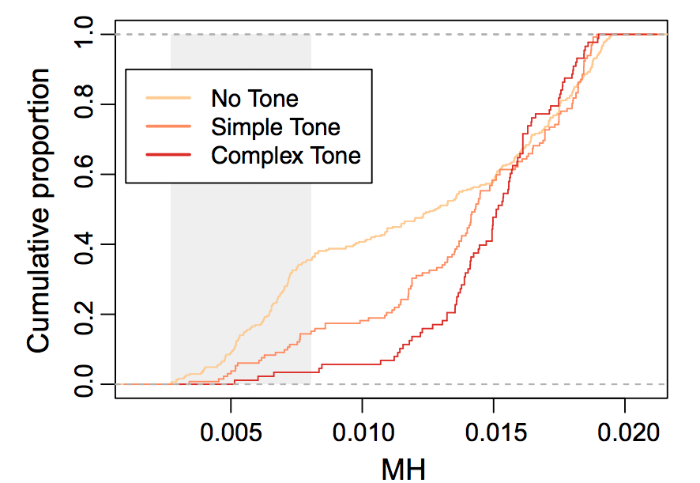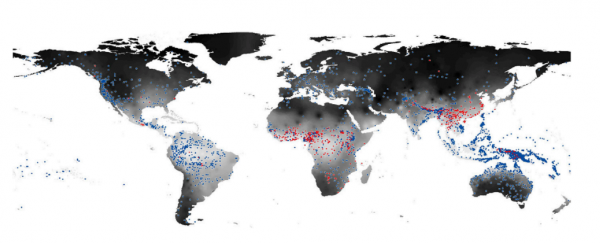Do climate and geography affect the way people speak? It's a question that linguists have debates for years, some saying that the sound systems featured in language are immune to ecological effects, and don't adapt to the way they change, while others argue that environmental factors, such as temperature and elevation, have directly influenced the sound made by certain cultures when they speak.
For example, recent studies have suggested a correlation between phonology - the systematic organisation of sounds in a language - and geographic factors such as temperature, plant cover, and terrain. Other studies have suggested a link between 'ejective' sounds and high elevation. Ejective sounds are characterised by an upward movement of the closed glottis (or vocal folds), and occur only in about 15 percent of languages.
But what's been lacking in these studies is experimental evidence to back up the theories, so a team led by anthropological linguistics professor, Caleb Everett from the University of Miami in the US, decided to investigate. Of the roughly 6,500 known languages spoken around the world, they examined more than 3,700, and analysed data taken from previous experiments on how various properties of the human larynx, or 'voice box', affect the sounds we make.
They were particularly interested in languages that use pitch or tone to denote meaning. For example, in Mandarin, a person can change the pitch they're using to change the meaning of a particular word. Of the 3,700 languages they studied, the team identified that 629 of them use what's known as complex tones - making use of three or more tones for sound contrast - and found that they are much more likely to occur in humid, tropical regions of the world. Most of them were found throughout Africa and Southeast Asia, but some were also found in humid regions of North America, Amazonia and New Guinea.
On the other hand, they found that because of the way dry air restricts the movement of a person's vocal cords, these complex tone patterns are unlikely to evolve over a long period of time in arid climates, so people living in the frigid Arctic or in dry desert environments have ended up with more simple tones.
Click here for a larger version of the map above, which was constructed using data from two large independently coded phonological databases, the World Atlas of Linguistic Structures online (WALS) of the Max Planck Institute in Germany and the Phonotactics Database of the Australian National University (ANU).
"In my estimation, it changes a bit our understanding of how languages evolve. It does not imply that languages are completely determined by climate, but that climate can, over the long haul, be one of the factors that helps shape languages," Everett said in a press release. "More broadly, this suggests another non-conscious way in which humans have adapted to their very different and harsh environments."
Publishing in the Proceedings of the National Academy of Sciences, the team suggests that inhaling dry air can cause dehydration of the voice box, which decreases the elasticity of the vocal folds within. This means that complex deviations of sounds - such as increased jitter and shimmer - are found in very cold or desiccated climates.
But that doesn't mean that climate was the only factor at play when languages were forming in cultural groups all over the world, as Everett explained to Stuart Mason Dambrot at Phys.org. "There are numerous cultural and language-internal factors that shape that evolution. We're just suggesting - in contrast to what linguists generally assume - that ambient aridity is one of them. This latter assumption is, from my perspective, not really supported by much other than traditional dogma," he said.
Everett now wants to figure out if climate has affected the way we open our mouths when we speak, telling Dambrot that perhaps people in warmer climates have evolved to open their mouths more than those faced with much drier ambient air:
"There's a hypothesis several anthropologists have put forward that languages in warmer climates tend to have higher rates of mouth opening. Linguists are quite skeptical of this hypothesis, but I think it might be supported and have a similar physiological grounding. Basically, my hypothesis is that languages in very cold climates have higher rates of mouth closure because of the ill-effects of cold and dry air – and it seems there may be support for this hypothesis."
 MH = Mean humidity. Credit: Everett C, Blasi DE, Roberts SG
MH = Mean humidity. Credit: Everett C, Blasi DE, Roberts SG
Source: Phys.org
